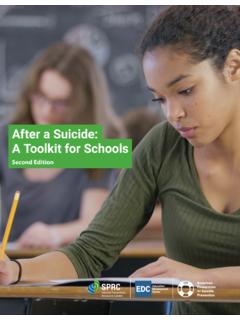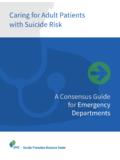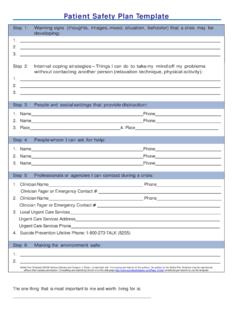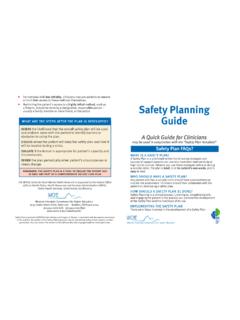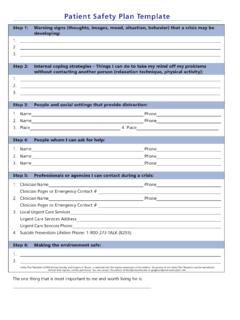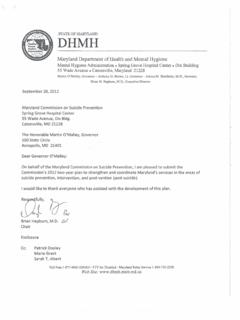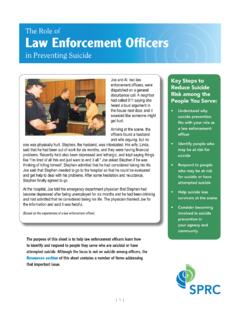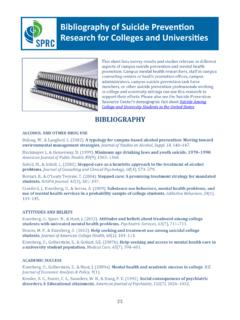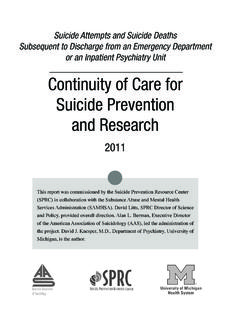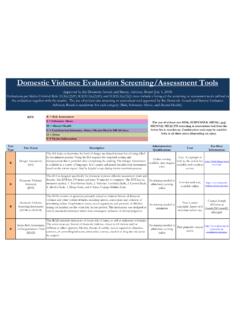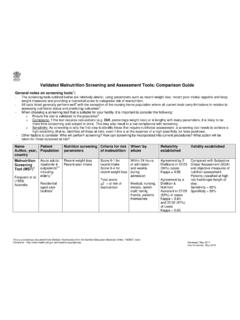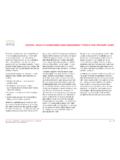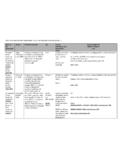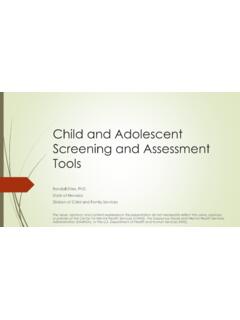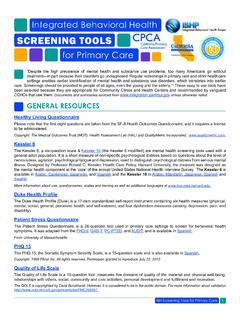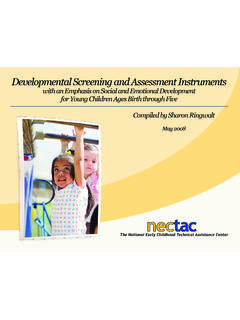Transcription of Suicide Screening and Assessment - SPRC
1 1 This publication introduces two approaches to evaluating Suicide risk and provides links to resources that offer additional guidance on choosing and implementing Suicide Screening and Assessment is no universal agreement on the definition or utility of either Suicide Screening or Assessment . Yet most experts agree that a process by which people at risk for Suicide can be identified and referred to treatment is an essential component of a comprehensive Suicide prevention program. We hope this publication will help you make an informed choice about integrating such a process into your Suicide prevention is the Difference between Suicide Screening and Suicide Assessment ? Suicide prevention experts usually use the term Suicide Screening to refer to a procedure in which a standardized instrument or protocol is used to identify individuals who may be at risk for Suicide . Suicide Screening can be done independently or as part of a more comprehensive health or behavioral health Screening .
2 Screening may be done orally (with the screener asking questions), with pencil and paper, or using a computer. Suicide Assessment usually refers to a more comprehensive evaluation done by a clinician to confirm suspected Suicide risk, estimate the immediate danger to the patient, and decide on a course of treatment. Although assessments can involve structured questionnaires, they also can include a more open-ended conversation with a patient and/or friends and family to gain insight into the patient s thoughts and behavior, risk factors ( , access to lethal means or a history of Suicide attempts), protective factors ( , immediate family support), and medical and mental health Are People Screened or Assessed for Suicide Risk? Screening can be applied either universally or selectively. A universal Screening program is applied to everyone in a population regardless of whether they are thought to be at a higher risk than the average person.
3 For example, a universal Screening program might include every student in a high school or every patient visiting a primary care programs are used to screen members of a group that research has shown to be at a higher than average risk for Suicide , regardless of whether particular members of that group are displaying any warning signs of elevated risk. A selective Screening program in a school district might target American Indian youth (who have a much higher Suicide rate than their non-Native peers) and LGBT youth (who have a much higher rate of Suicide attempts than heterosexual youth). A selective Screening program in a primary care office might target only those patients being treated for depression or a substance abuse Assessment is characteristically used when there is some indication that an individual is at risk for Suicide ; for example, when a patient has been identified as such by a Suicide Screening or a clinician notices some signs that a patient may be at risk.
4 Suicide Assessment is also used to help develop treatment plans and track the progress of individuals who are receiving mental health treatment because they have been assessed as being at risk for Screening and AssessmentSuicide Prevention Resource Center 2 Are Suicide Screening and Assessment Effective?Several expert panels have reviewed the research on Suicide Screening and Department of Veterans Affairs/Department of Defense Assessment of Risk for Suicide Working Group (2013) concluded that Suicide risk Assessment remains an imperfect science, and much of what constitutes best practice is a product of expert opinion, with a limited evidence base. The Preventive Services Task Force (2013) reported that limited evidence suggests that primary care-feasible Screening instruments may be able to identify adults at increased risk of Suicide and that evidence that Screening is effective is more limited in older adults and adolescents.
5 Instruments that successfully identify adults at risk for Suicide tend to produce a high rate of false positives that is, they incorrectly attribute Suicide risk to people who are not at risk. The task force suggested that Screening for Suicide may be more effective when embedded in broader mental health or depression screenings, especially in primary care American Academy of Pediatrics Committee on Adolescence (2007) reported that no specific tests are capable of identifying a suicidal person and to be oversensitive and underspecific and lack predictive value. The American Psychiatric Association Work Group on Suicidal Behaviors (2003) concluded that although Suicide Assessment scales have been developed for research purposes, they lack the predictive validity necessary for use in routine clinical practice. Therefore, Suicide Assessment scales may be used as aids to Suicide Assessment but should not be used as predictive instruments or as substitutes for a thorough clinical evaluation.
6 What Do Experts Recommend about Suicide Screening and Assessment ?Despite the mixed research findings on the ability of both Screening and Assessment to accurately predict who may be at risk of Suicide , there is fairly widespread agreement that both instruments can be useful if conducted by trained practitioners within a more comprehensive effort in which individuals identified as being at risk for Suicide receive further evaluation and appropriate treatment. The following are summaries of some of the conclusions and recommendations regarding Screening and Assessment issued by several expert panels and task National Strategy for Suicide Prevention (NSSP): Goals and Objectives for Action (2012) reports that Clinical preventive services, including Suicide Assessment and preventive Screening by primary care and other health care providers, are crucial to assessing Suicide risk and connecting individuals at risk for Suicide to available clinical services and other sources of care.
7 Objective of the NSSP recommends training for mental health and substance abuse providers on the recognition, Assessment , and management of at-risk behavior, and the delivery of effective clinical care for people with Suicide risk. The SAMHSA-led Lessons Learned Working Group (2012) recommended that school-based Suicide Screening should be implemented after a strategic planning effort has determined that such a program is needed and that Screening efforts should ideally include related training, education or outreach before or concurrently with Screening campaigns in order to improve Screening participation rates and to establish a more robust network of support for youths at elevated risk for Suicide . The Joint Commission s National Patient Safety Goal (2014) recommends that behavioral health care and psychiatric hospitals, as well as general hospitals treating patients for emotional or behavioral disorders, conduct a risk Assessment that identifies specific characteristics of the individual served and environmental features that may increase or decrease the risk for Suicide .
8 The National Action Alliance Clinical Care & Intervention Task Force (2012) concluded that Suicide Assessment should be completed by a professional with appropriate and specific training in assessing for and evaluating Suicide risk. This professional must have the skills to engage patients in crisis and to elicit candid disclosures of Suicide risk in a non-threatening environment. 3 The American Psychiatry Association Work Group on Suicidal Behaviors (2003) developed Practice Guidelines and Treatment of Patients with Suicidal Behaviors. Section II of these guidelines includes recommendations for a psychiatric evaluation that will provide information about the patient s history, current circumstances, and mental state and will include direct questioning about suicidal thinking and behaviors. The American Pediatric Association Committee on Adolescence (2007) recommended that primary care pediatricians should be comfortable Screening for Suicide and mood disorders by asking about emotional difficulties, identifying lack of developmental progress, and estimating level of distress, impairment of functioning, and level of danger to self and others.
9 They suggest that the best way to assess for suicidal ideation is by directly asking or Screening via self-report and that self-administered scales can be useful for Screening , because adolescents may disclose information about suicidality in self-report that they deny in person and that adolescents who endorse suicidality on a scale should always be assessed clinically. How Should I Choose a Suicide Screening or Assessment Instrument or Program? You should choose an instrument or approach based on the following:1. The evidence showing it will be effective with the population you are planning to screen or assess 2. The resources you have available to devote to this activityQuestions to ask when choosing an instrument or approach include the following: Has the instrument been evaluated and found effective? Is there a cost associated with using the instrument? For what age group was the instrument developed?
10 How long does it take to screen or assess an individual? Who will conduct the Screening or Assessment ? Paraprofessionals? Health care professionals? Mental health professionals? Does using the instrument require training? If so, how expensive is this training, and how many people will you need to train? If you are planning to implement Screening , are you planning to screen universally or selectively?It is also essential to remember the advice of the experts: Identifying a Screening or Assessment instrument and training people to use it is only part of the process. It is critical to be prepared to help individuals who are identified as being at risk to stay safe, receive clinical evaluation, and receive treatment. The following resources can help you make decisions about whether engaging in Suicide Screening or Assessment is appropriate for your organization and setting and, if so, how to design and implement this Screening and Assessment : Selected ResourcesAssessment of Suicidal Behaviors and Risk among Children and AdolescentsD.
